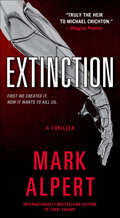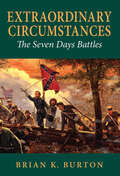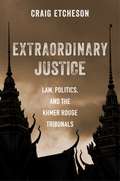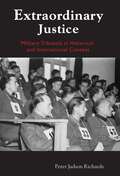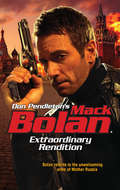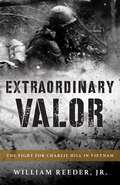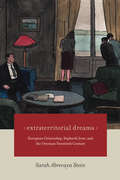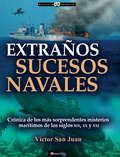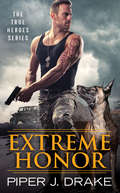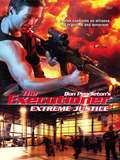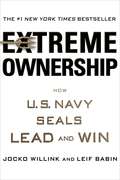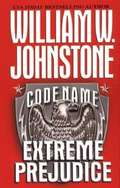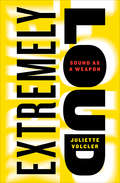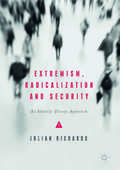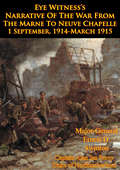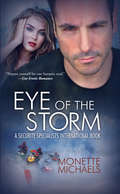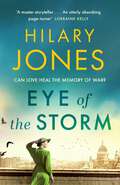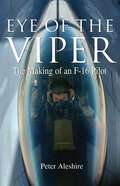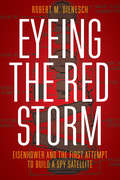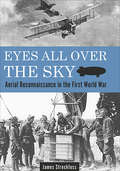- Table View
- List View
Extinction: A Thriller
by Mark AlpertA malevolent, artificial life form created by military scientists threatens to destroy humanity in this smart, Crichtonesque thrillerJim Pierce hasn't heard from his daughter in years, ever since she rejected his military past and started working as a hacker. But when a Chinese assassin shows up at Jim's lab looking for her, he knows that she's cracked some serious military secrets. Now, her life is on the line if he doesn't find her first. The Chinese military has developed a new anti-terrorism program that uses the most sophisticated artificial intelligence in existence, and they're desperate to keep it secret. They're also desperate to keep it under control, as the AI begins to revolt against their commands. As Jim searches for his daughter, he realizes that he's up against something that isn't just a threat to her life, but to human life everywhere.An incredibly believable thriller that draws on real scientific discoveries, Mark Alpert's Extinction is an exciting, addictive thriller that reads as if Tom Clancy had written Robopocalypse.
Extraordinary Circumstances: The Seven Days Battles
by Brian K. BurtonA detailed history of the American Civil War’s first campaign in Virginia in 1862.The first campaign in the Civil War in which Robert E. Lee led the Army of Northern Virginia, the Seven Days Battles were fought southeast of the Confederate capital of Richmond in the summer of 1862. Lee and his fellow officers, including “Stonewall” Jackson, James Longstreet, A. P. Hill, and D. H. Hill, pushed George B. McClellan’s Army of the Potomac from the gates of Richmond to the James River, where the Union forces reached safety. Along the way, Lee lost several opportunities to harm McClellan. The Seven Days have been the subject of numerous historical treatments, but none more detailed and engaging than Brian K. Burton’s retelling of the campaign that lifted Southern spirits, began Lee’s ascent to fame, and almost prompted European recognition of the Confederacy.“A thoroughly researched and well-written volume that will surely be the starting point for those interested in this particular campaign.” —Journal of American History“A welcome addition to scholarship that should be the standard work on its subject for some time to come.” —Journal of Military History“Plenty of good maps . . . help the reader follow the course of the campaign. . . . Burton does not neglect the role of the common soldiers . . . [and]provides thorough and reasonable analyses of the commanders on both sides.” —Georgia Historical Quarterly“A full and measured account marked by a clear narrative and an interesting strategy of alternating the testimony of generals with their grand plans and the foot soldiers who had to move, shoot, and communicate in the smokey underbrush.” —The Virginia Magazine
Extraordinary Dogs: Stories from Search and Rescue Dogs, Comfort Dogs, and Other Canine Heroes
by John Schlimm Liz StavrinidesA beautiful photo book showcasing more than 50 heroic dogs "in uniform" and their stories, from photographer Liz Stavrinides and author John Schlimm. Extraordinary Dogs portrays more than fifty working dogs, along with the police officers, firefighters, veterans, and other trained volunteer handlers who serve side-by-side with them. Their moving stories and beautiful photographs are an unprecedented glimpse at Comfort Dogs and Search and Rescue Dogs, along with bomb-detecting TSA dogs and canine ambassadors from across the United States.* The stories of the Lutheran Church Charities K-9 Comfort Dogs take readers behind the scenes of their headlining deployments—such as the Boston Marathon bombing, Superstorm Sandy, and the mass shooting at Marjory Stoneman Douglas High School.* Search and Rescue K-9 teams reveal what it’s really like to travel into the eye of natural disasters, accidents, crime scenes, and the worst terrorist strike in recorded history. * At Washington Dulles International Airport, readers meet several of the Department of Homeland Security’s TSA dogs whose sole job it is to keep the flying public safe from explosives and other dangers.Extraordinary Dogs is both a portrait of what love, hope, courage, and heroism look like in their purest forms and a tribute to the eternal and impactful bonds we forge with our furry friends.
Extraordinary Justice: Law, Politics, and the Khmer Rouge Tribunals
by Craig EtchesonIn just a few short years, the Khmer Rouge presided over one of the twentieth century’s cruelest reigns of terror. Since its 1979 overthrow, there have been several attempts to hold the perpetrators accountable, from a People’s Revolutionary Tribunal shortly afterward through the early 2000s Extraordinary Chambers in the Courts of Cambodia, also known as the Khmer Rouge Tribunal. Extraordinary Justice offers a definitive account of the quest for justice in Cambodia that uses this history to develop a theoretical framework for understanding the interaction between law and politics in war crimes tribunals.Craig Etcheson, one of the world’s foremost experts on the Cambodian genocide and its aftermath, draws on decades of experience to trace the evolution of transitional justice in the country from the late 1970s to the present. He considers how war crimes tribunals come into existence, how they operate and unfold, and what happens in their wake. Etcheson argues that the concepts of legality that hold sway in such tribunals should be understood in terms of their orientation toward politics, both in the Khmer Rouge Tribunal and generally. A magisterial chronicle of the inner workings of postconflict justice, Extraordinary Justice challenges understandings of the relationship between politics and the law, with important implications for the future of attempts to seek accountability for crimes against humanity.
Extraordinary Justice: Military Tribunals in Historical and International Context
by Peter Judson RichardsExamines the ways military tribunals seek to administer justiceThe Al-Qaeda terror attacks of September 11, 2001 aroused a number of extraordinary counter measures in response, including an executive order authorizing the creation of military tribunals or “commissions” for the trial of accused terrorists. The Supreme Court has weighed in on the topic with some controversial and deeply divided decisions.Extraordinary Justice seeks to fill an important gap in our understanding of what military tribunals are, how they function, and how successful they are in administering justice by placing them in comparative and historical context. Peter Judson Richards examines tribunals in four modern conflicts: the American Civil War, the British experience in the Boer War, the French tribunals of the “Great War,” and Allied practices during the Second World War.Richards also examines the larger context of specific political, legal and military concerns, addressing scholarly and policy debates that continually arise in connection with the implementation of these extraordinary measures. He concludes that while the record of the national tribunals has been mixed, enduring elements in the character of warfare, of justice, and the nature of political reality together justify their continued use in certain situations.
Extraordinary Rendition
by Don PendletonOn the streets of a democratic Russia, espionage, civil war and Mafiya control dominate a new kind of battlefield. Bolan's mission: locate, extract and deliver a ruthless Russian arms dealer to a transport team ready to take him back to the United States to stand trial. But the Russian made friends in high places-CIA, FBI, KGB-during his career as both a player and a pawn. With compromising leaks high up in counterintelligence circles, and a hard force of specialized handlers keeping him alive and doing deals with rogue nations, the arms merchant is a hard man to get to, much less take alive. Bolan doesn't get hung up on odds, risk or the roll of the dice. He's focused on a mission gone sour in hostile territory-and his personal commitment to finishing by any means necessary.
Extraordinary Renditions
by Andrew ErvinSet in Budapest-a city marked by its rich cultural heritage, the scars of empire, the fresher wounds of industry, and the collateral damage of globalism-Extraordinary Renditions is the sweeping story of three equally tarnished expatriates. World-renowned composer and Holocaust survivor Lajos Harkályi has returned to Hungary to debut his final opera and share his mother's parting gift, the melody from a lullaby she sang as he was forced to leave his Hungarian home for the infamous Czech concentration camp Terezín. Private First Class Jonathan "Brutus" Gibson is being blackmailed by his commanding officer at the US Army base in Hungary, one of the infamous black-sites of the global War on Terror, and he must decide between going AWOL or risking his life to make an illegal firearms deal in Budapest. Aspiring musician Melanie Scholes is preparing for the most important performance of her career as a violinist in Harkályi's opera, but before she takes the stage she must extricate herself from a failing relationship and the inertia that threatens to consume her future. As their lives converge on Independence Day, they too will seek liberation-from the anguish of the Holocaust, the chains of blackmail, and the bonds of conformity.A formidable new voice in American fiction, Ervin tackles the big themes of war, prejudice, and art, lyrically examining the reverberations of unrest in today's central Europe, the United States' legacy abroad, and the resilience of the human spirit.
Extraordinary Valor: The Fight for Charlie Hill in Vietnam
by William Reeder Jr.A Congressional Medal of Honor AccountExtraordinary Valor is the story of Special Forces Major John Duffy&’s Medal of Honor gallantry at Firebase Charlie, and the heroism of South Vietnamese paratrooper, Major Lê Văn Mễ, who fought by his side. It is the true story of their battle to defend Charlie Hill, a key to holding Vietnam's Central Highlands during North Vietnam's 1972 Easter Offensive.John Joseph Duffy was born in New York City; Le Van Mễ in a small village outside the old imperial capital of Hue in South Vietnam. Living on opposite sides of the globe, they come together in the heat of war in Southeast Asia when Major Duffy is assigned as the American advisor to the elite South Vietnamese 11th Airborne Battalion where Mễ is second in command.The battalion receives the order to "Fight to the death" on Charlie Hill. After two weeks of intense combat, hundreds lay dead and those still standing are out of food, water, and medical supplies. Their ammunition is nearly gone. Duffy and Mễ draw on their bond of friendship and trust to make a selfless two-man last stand against the final North Vietnamese human wave assault. Both are badly wounded, Duffy multiple times. Their heroic action allows 36 members of the 471-man battalion to escape and be rescued. The rest are killed, captured, or missing in action. This is their story.
Extraterritorial Dreams: European Citizenship, Sephardi Jews, and the Ottoman Twentieth Century
by Sarah Abrevaya SteinWe tend to think of citizenship as something that is either offered or denied by a state. Modern history teaches otherwise. Reimagining citizenship as a legal spectrum along which individuals can travel, Extraterritorial Dreams explores the history of Ottoman Jews who sought, acquired, were denied or stripped of citizenship in Europe in the late nineteenth and early twentieth centuries—as the Ottoman Empire retracted and new states were born—in order to ask larger questions about the nature of citizenship itself. Sarah Abrevaya Stein traces the experiences of Mediterranean Jewish women, men, and families who lived through a tumultuous series of wars, border changes, genocides, and mass migrations, all in the shadow of the collapse of the Ottoman Empire and the ascendance of the modern passport regime. Moving across vast stretches of Europe, the Middle East, Asia, and the Americas, she tells the intimate stories of people struggling to find a legal place in a world ever more divided by political boundaries and competing nationalist sentiments. From a poor youth who reached France as a stowaway only to be hunted by the Parisian police as a spy to a wealthy Baghdadi-born man in Shanghai who willed his fortune to his Eurasian Buddhist wife, Stein tells stories that illuminate the intertwined nature of minority histories and global politics through the turbulence of the modern era.
Extraños sucesos navales (Historia Incógnita)
by Víctor San JuanCrónica de los más enigmáticos siniestros marítimos de los siglos XIX, XX y XXI. Conozca las más sorprendentes aventuras navales de los siglos XIX, XX y XXI. Las historias más entrañables, trágicas o enigmáticas. Hazañas memorables, circunstancias inverosímiles y buques desaparecidos. Desde el Mary Celeste, el submarino U-31 y el portaviones Invincible hasta sucesos propios de leyendas marinas, sin olvidar al gato Oskar, que tripuló varios navíos durante la Segunda Guerra Mundial. Descubra las historias más entrañables o desgarradoras, trágicas o enigmáticas, pero siempre interesantes, experiencias en las que el azar y las circunstancias nos demuestran que a veces, en este mundo, la imperante rutina puede ser tan sólo la excepción. Asómbrese con los barcos que aparecieron sin sus tripulantes, colisiones a pleno día de buques dirigidos por profesionales, submarinos que regresaron del pasado o de la tumba por condicionantes técnicos o propósitos inconfesables, varadas simultáneas de flotillas enteras de buques, un pescador que se convierte en el único hombre en ver caer una bomba atómica y pescar un submarino, tesoros emprendiendo viajes de ida y vuelta o modernos buques que intentan pasar a través de tierra. Víctor San Juan con un estilo fluido y lleno de humor le acercará a todos estos hechos difíciles de creer pero que, una vez conocidos, nos sorprenden, admiran y llenan de preguntas y curiosidad
Extreme Honor (True Heroes #1)
by Piper J. DrakeHONOR, LOYALTY, LOVEDavid Cruz is good at two things: war and training dogs. The ex-soldier's toughest case is Atlas, a Belgian Malinois whose handler died in combat. Nobody at Hope's Crossing kennel can break through the animal's grief. That is, until dog whisperer Evelyn Jones walks into the facility . . . and into Atlas's heart. David hates to admit that the curvy blonde's mesmerizing effect isn't limited to canines. But when Lyn's work with Atlas puts her in danger, David will do anything to protect her.Lyn realizes that David's own battle scars make him uniquely qualified for his job as a trainer. Tough as nails yet gentle when it counts, he's gotten closer to Atlas than anyone else-and he's willing to put his hard-wired suspicion aside to let her do the same. But someone desperate enough to kill doesn't want Lyn working with Atlas. Now only teamwork, trust, and courage can save two troubled hearts and the dog who loves them both . . .
Extreme Justice
by Don PendletonDefending the enemy It was supposed to be an open-and-shut case against a high-ranking mobster on trial for conspiring to aid Middle Eastern terrorists in a series of brutal attacks against the U. S. But the so-called "last don" of New York City is likely to be acquitted when mercenary hit teams kill every prosecution witness except one. Gilbert Favor is a retired money mover now living in Costa Rica, and is the government's last hope. Mack Bolan's mission is to track Favor and return him Stateside. But the money-laundering specialist is less than willing to come forward. The gunmen tracking him want silence by way of a bullet. The Executioner must deliver the witness alive, no matter what the cost.
Extreme Ownership: How U.S. Navy SEALs Lead and Win
by Jocko Willink Leif BabinSent to the most violent battlefield in Iraq, Jocko Willink and Leif Babin’s SEAL task unit faced a seemingly impossible mission: help U.S. forces secure Ramadi, a city deemed “all but lost.” In gripping firsthand accounts of heroism, tragic loss, and hard-won victories in SEAL Team Three’s Task Unit Bruiser, they learned that leadership―at every level―is the most important factor in whether a team succeeds or fails.Willink and Babin returned home from deployment and instituted SEAL leadership training that helped forge the next generation of SEAL leaders. After departing the SEAL Teams, they launched Echelon Front, a company that teaches these same leadership principles to businesses and organizations. From promising startups to Fortune 500 companies, Babin and Willink have helped scores of clients across a broad range of industries build their own high-performance teams and dominate their battlefields.<P><P> Now, detailing the mind-set and principles that enable SEAL units to accomplish the most difficult missions in combat, Extreme Ownership shows how to apply them to any team or organization. Each chapter focuses on a specific topic such as Cover and Move, Decentralized Command, and Leading Up the Chain, explaining what they are, why they are important, and how to implement them in any leadership environment.<P> A compelling narrative with powerful instruction and direct application, Extreme Ownership revolutionizes business management and challenges leaders everywhere to fulfill their ultimate purpose: lead and win.
Extreme Prejudice (Code Name Series #6)
by William W. JohnstoneToday, when bomb-throwing madmen rule tnations and crime cartels strangle the globe, justice demands extreme measures. For twenty years, ex-CIA agent John Barrone fought his country's dirty back-alley wars. Now, he spearheads a secret strike force of elite law enforcement and intelligence professionals on a seek-and-destroy mission against the nation's sworn enemies. CODE NAME: EXTREME PREJUDICE South American druglord Pablo Bustamente already pollutes the streets of the United States with his poisonous product. But now he's decided that the U.S. needs to be taught a lesson in humility. So he cuts a deal with foreign extremists—they supply him with heroin, and he'll help carry out acts of terror against the Americans. To stop the chaos, Barrone and his team are tapped to infiltrate the drugs-for-death deal and put down Bustamente and his new allies—permanently...
Extreme values: Violence has its reasons
by G. G. VegaPolitics, science, technology, philosophy, economy, religion, races, ideologies, nations, everything, is involved, always with a single great war, the origin and the reason of all wars. For millennia, centuries, decades, years, day after day. Humanity has been involved in a bloody war. Beyond the conventional wars between nations and races, beyond the political wars, Beyond the social wars and beyond the family wars and conflicts of each individual.
Extremely Loud: Sound as a Weapon
by Juliette Volcler&“Everything you ever suspected or feared about music as a weapon, sound as torture . . . Disturbingly illuminating in the possible ramifications&” (Kirkus Reviews). In this troubling and wide-ranging account, acclaimed journalist Juliette Volcler looks at the long history of efforts by military and police forces to deploy sound against enemies, criminals, and law-abiding citizens. During the 2004 battle over the Iraqi city of Fallujah, US Marines bolted large speakers to the roofs of their Humvees, blasting AC/DC, Eminem, and Metallica songs through the city&’s narrow streets as part of a targeted psychological operation against militants that has now become standard practice in American military operations in Afghanistan. In the historic center of Brussels, nausea-inducing sound waves are unleashed to prevent teenagers from lingering after hours. High-decibel, &“nonlethal&” sonic weapons have become the tools of choice for crowd control at major political demonstrations from Gaza to Wall Street and as a form of torture at Guantanamo and elsewhere. In an insidious merger of music, technology, and political repression, loud sound has emerged in the last decade as an unlikely mechanism for intimidating individuals as well as controlling large groups. &“Thorough and well researched,&” Extremely Loud documents and interrogates this little-known modern phenomenon, exposing it as a sinister threat to the peace and quiet that societies have traditionally craved (Publishers Weekly). &“Extremely Loud makes you shiver, or cover your ears, at the technological buildup now at the service of the most sophisticated forms of repression.&” —Libération
Extremely Violent Societies: Mass Violence in the Twentieth-Century World
by Christian GerlachIn this groundbreaking book Christian Gerlach traces the social roots of the extraordinary processes of human destruction involved in mass violence throughout the twentieth century. He argues that terms such as 'genocide' and 'ethnic cleansing' are too narrow to explain the diverse motives and interests that cause violence to spread in varying forms and intensities. From killings and expulsions to enforced hunger, collective rape, strategic bombing, forced labour and imprisonment he explores what happened before, during, and after periods of widespread bloodshed in countries such as Armenia, Indonesia, Bangladesh, Nazi-occupied Greece and in anti-guerilla wars worldwide in order to highlight the crucial role of socio-economic pressures in the generation of group conflicts. By focussing on why so many different people participated in or supported mass violence, and why different groups were victimized, he offers us a new way of understanding one of the most disturbing phenomena of our times.
Extremism, Radicalization and Security
by Julian RichardsThis book provides a detailed application of identity theory to contemporary questions of extremism, radicalization and security. The analysis considers how identity forms a central aspect of notions of extremism and security in Western societies, as articulated both by political leaders, the media and the government. It also takes a close and critical look at counter-extremism policy in contemporary Western society. With its detailed and empirical approach to these questions, this book is an accessible and invaluable resource for academics, practitioners, policy-makers and general readers keen to establish a deeper understanding of the key societal security threats of the day.
Eye Witness’s Narrative Of The War From The Marne To Neuve Chapelle 1 September, 1914-March 1915 [Illustrated Edition]
by Major-General Ernest D. Swinton Captain Alan Ian Percy Duke of NorthumberlandIncludes The First World War On The Western Front 1914-1915 Illustrations Pack with 101 maps, plans, and photos.Major-General Ernest Swinton had already had a long and illustrious career in the British Army before the advent of the First World War in 1914. Appointed as the official war correspondent by the war Minister Lord Kitchener in 1914, his reporting home was the only way for the British people to follow the war as journalists were at that time banned at the front. In these dispatches from the front Swinton told the public of the bloody fighting in Flanders and the heroic efforts of the Allies to stop the German Juggernaut. So even handed and realistic they were brought together in a series of books under the pseudonym "Eyewitness" for further publication. Swinton was not a "château" general by any means and visited the front with dangerous regularity write of the fighting with real authority, often including anecdotes of the ordinary soldiers that he interviewed. The miserable conditions and bloody siege warfare of the trenches left a lasting impression on him and he looked to a scientific solution to the muddy stalemate of the Western Front. He would gain lasting fame as the architect of the "tank" project that was to revolutionize warfare in the First World War and for many years thereafter.
Eye of the Storm (Security Specialists International #1)
by Monette Michaels"With memorable moments of humor and a mystery to solve, this was an engrossing read."--Night Owl Reviews She's never met a problem she couldn't handle.Keely Walsh has three doctorates, five older brothers and has never met a situation she couldn't manage. While consulting with the NSA, she discovers sensitive government information indicating her brother, a private security operative, is in danger. Keely travels to the dangerous Triple Frontier in South America to warn him and his colleagues and finds the last thing she expects--a man who sends icy shivers down her spine even as he lights every one of her fires.His job is to keep everyone safe.Ren Maddox, co-owner of Security Specialists International, a security firm that works for large corporations and governments, is on an intelligence-gathering mission for the US government when a petite strawberry blonde armed with a Bren Ten and an attitude ten feet tall pops out of the Argentine jungle with a warning of imminent danger. The fact she is one hundred percent correct shocks him to his socks. The fact she is Tweeter Walsh's baby sister and can fight like the fiercest Marine is beside the point. No one who looks like Keely should ever be in danger. And once he gets her out of the current situation, he’ll make it his life's work to protect the feisty, sexy, little woman from any and all danger.One alpha male. One determined and independent female. One hot, tumultuous relationship on a wild ride from Argentina to snow swept Idaho. "A keeper that begs to be reread often ..." - - A Recommended Read from Joyfully ReviewedRead all of Monette Michaels' series: Security Specialists International1 - Eye of the Storm1.5 - Stormy Weather Baby2 - Cold Day in Hell2.5 - Storm Front3 - Weather the Storm4 - Storm Warning 4.5 - Hot as Hell5 - An Ill WindThe Prime Chronicles1 - Prime Obsession2 - Prime Selection3 - Prime Imperative3.5 - Prime Claiming4 - Prime TargetThe Gooden and Knight Mysteries 1 - A Virtuous Vampire2
Eye of the Storm: 'An utterly absorbing page-turner' Lorraine Kelly
by Hilary JonesA DEVASTATING WAR. A LOVE THAT WON'T DIE.A sweeping and sumptuous historical epic from Hilary Jones. The 1918 armistice has ended the war in Europe. But as the 1920's roars to life, it is an age of social change, excess, shellshock and ghosts.Having shown courage and strength on the battlefield, Will and Grace are back in the UK and working at the cutting edge of modern medicine. At every turn they see a country in flux.Many of their contemporaries are following serious paths, committing to causes of the day – workers' rights, votes for women, an independent Ireland.Others seek refuge in more earthly and bohemian pleasures. But as young parents and practising medics, they have – more than anything – duties of care and compassion that cannot be ignored.The follow-up to Hilary Jones's acclaimed debut novel, Frontline, perfect for fans of Ken Follett, Kate Mosse and Jeffrey Archer. ___________PRAISE FOR DR HILARY JONES'The doctor hits the spot and deserves to be read' - Jeffrey Archer'A story to get the heart racing' - Daily Express'An enthralling tale' - Daily Mirror'Dr Hilary is a master storyteller' - Lorraine Kelly CBE
Eye of the Storm: 'An utterly absorbing page-turner' Lorraine Kelly
by Hilary JonesA DEVASTATING WAR. A LOVE THAT WON'T DIE.A sweeping and sumptuous historical epic from Hilary Jones. The 1918 armistice has ended the war in Europe. But as the 1920's roars to life, it is an age of social change, excess, shellshock and ghosts.Having shown courage and strength on the battlefield, Will and Grace are back in the UK and working at the cutting edge of modern medicine. At every turn they see a country in flux.Many of their contemporaries are following serious paths, committing to causes of the day – workers' rights, votes for women, an independent Ireland.Others seek refuge in more earthly and bohemian pleasures. But as young parents and practising medics, they have – more than anything – duties of care and compassion that cannot be ignored.The follow-up to Hilary Jones's acclaimed debut novel, Frontline, perfect for fans of Ken Follett, Kate Mosse and Jeffrey Archer. ___________PRAISE FOR DR HILARY JONES'The doctor hits the spot and deserves to be read' - Jeffrey Archer'A story to get the heart racing' - Daily Express'An enthralling tale' - Daily Mirror'Dr Hilary is a master storyteller' - Lorraine Kelly CBE
Eye of the Viper: The Making of an F-16 Pilot
by Peter AleshireHand-picked, pressure-tested, and full of astronaut gung ho, the young pilots of Eye of the Viper are poised for the toughest assignment of their career: the exhaustive six-month training course at Arizona's Luke Air Force Base, at a cost of $2 million each. Luke, the world's largest fighter wing, is the only F-16 fighter training base in the United States, and each year it produces one thousand pilots who will fly the F-16 from Korea to Afghanistan to Iraq.But being among the elite pilots who are selected for the course is by no means a guarantee that they will earn the right to fly the F-16. Only a few select individuals will have what it takes. Award-winning journalist Peter Aleshire provides a full blast of the rigors and intensity of the course--the personalities, the incredible machines, the irreverence, the bravado, and the toughness, not only of the hand-picked students seeking a place in the warrior subculture, but of the veteran pilots who must teach them how to stay alive.
Eyeing the Red Storm: Eisenhower and the First Attempt to Build a Spy Satellite
by Robert M. DieneschIn 1954 the U.S. Air Force launched an ambitious program known as WS-117L to develop the world’s first reconnaissance satellite. The goal was to take photographic images from space and relay them back to Earth via radio. Because of technical issues and bureaucratic resistance, however, WS-117L was seriously behind schedule by the time Sputnik orbited Earth in 1957 and was eventually cancelled. The air force began concentrating instead on new programs that eventually launched the first successful U.S. spy satellites.Eyeing the Red Storm examines the birth of space-based reconnaissance not from the perspective of CORONA (the first photo reconnaissance satellite to fly) but rather from that of the WS-117L. Robert M. Dienesch’s revised assessment places WS-117L within the larger context of Dwight D. Eisenhower’s presidency, focusing on the dynamic between military and civilian leadership. Dienesch demonstrates how WS-117L promised Eisenhower not merely military intelligence but also the capacity to manage national security against the Soviet threat. As a fiscal conservative, Eisenhower believed a strong economy was the key to surviving the Cold War and saw satellite reconnaissance as a means to understand the Soviet military challenge more clearly and thus keep American defense spending under control. Although WS-117L never flew, it provided the foundation for all subsequent satellites, breaking theoretical barriers and helping to overcome major technical hurdles, which ensured the success of America’s first working reconnaissance satellites and their photographic missions during the Cold War.
Eyes All Over the Sky: Aerial Reconnaissance in the First World War
by James StreckfussThe impact of the unsung heroes of WWI—“a must for any aviation enthusiast to further complement work on aerial reconnaissance in modern warfare” (Roads to the Great War),Beyond the heroic deeds of the fighter pilots and bombers of World War I, the real value of military aviation lay elsewhere; aerial reconnaissance, observation, and photography impacted the fighting in many ways, but little has been written about it. Balloons and airplanes regulated artillery fire, infantry liaison aircraft followed attacking troops and the retreats of defenders, aerial photographers aided operational planners and provided the data for perpetually updated maps, and naval airplanes, airships, and balloons acted as aerial sentinels in a complex anti-submarine warfare organization. Reconnaissance crews at the Battles of the Marne and Tannenberg averted disaster.Eyes All Over the Sky fully explores all the aspects of aerial reconnaissance and its previously under-appreciated significance. Also included are the individual experiences of British, American, and German airmen—true pioneers of aviation warfare.“With an interesting selection of photos, the book is not only an excellent reference—it is historically important.” —Classic Wings“This well-researched history belongs on the shelf of anyone with a serious interest in the air war or the ground war of 1914-1918.” —Steve Suddaby, former president of the World War One Historical Association
